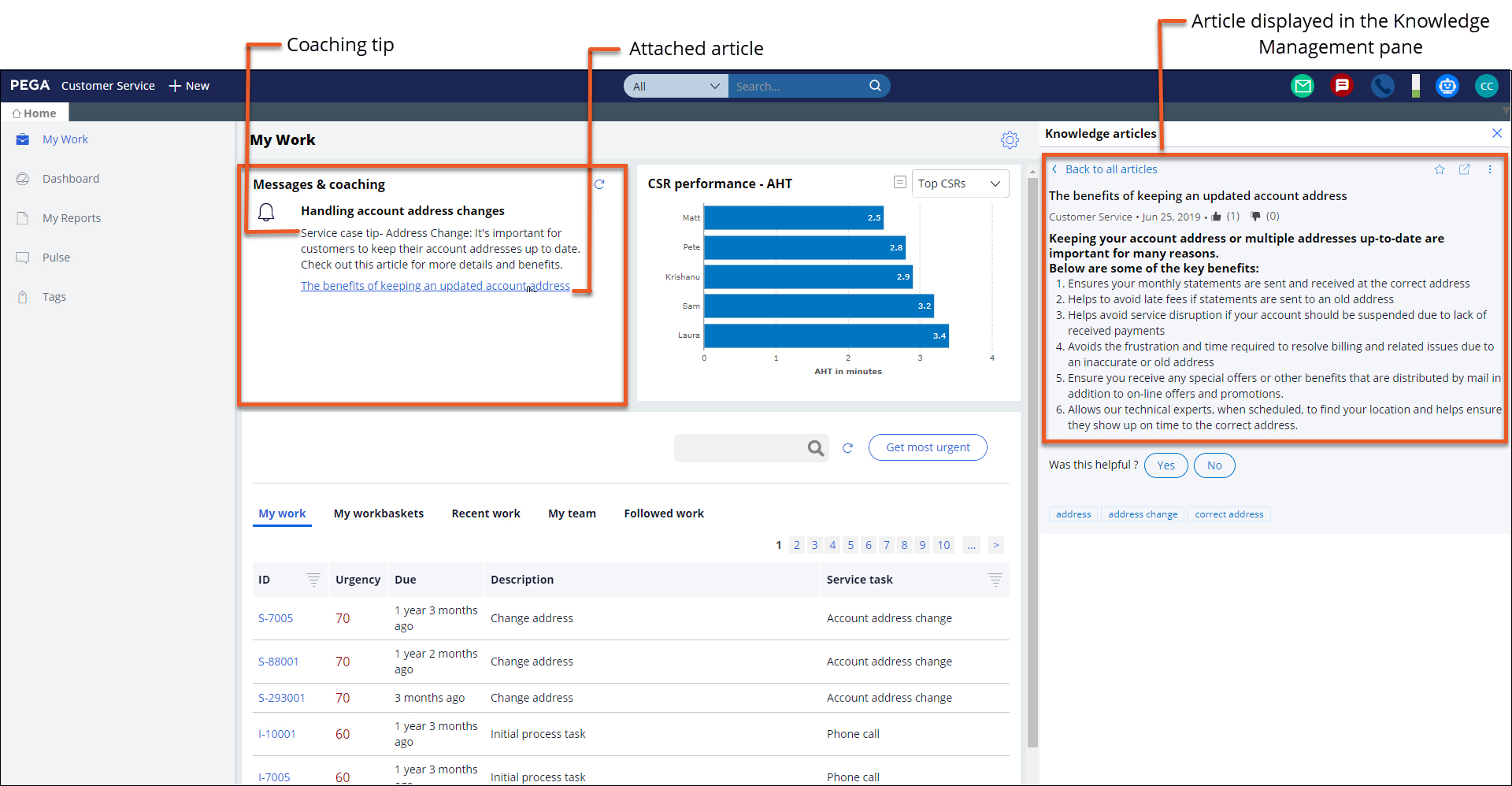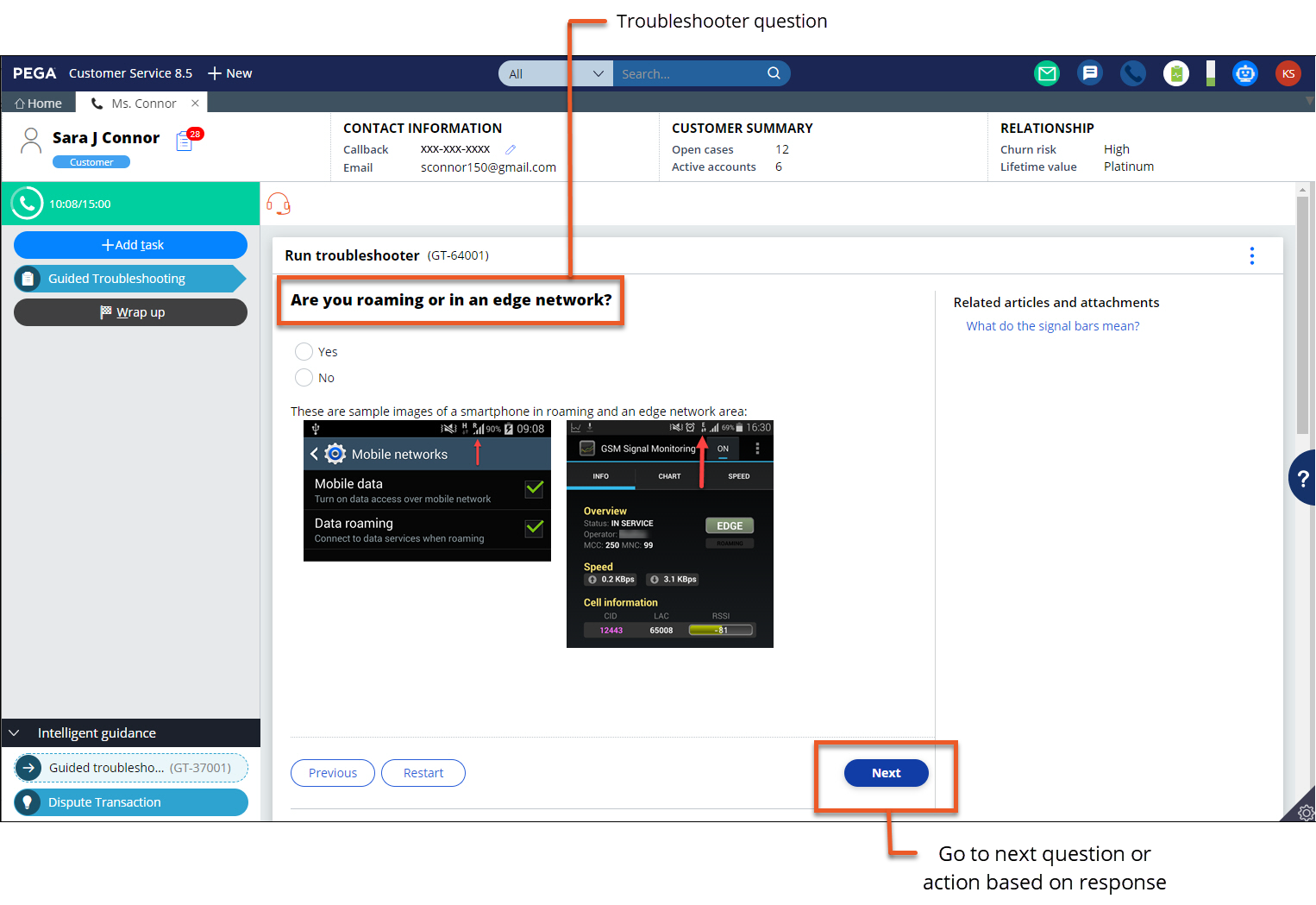Pega Knowledge capabilities
Pega Knowledge provides a rich set of features to enhance your CSR and customer experience. This section describes some key capabilities that are most relevant to Pega Customer Service.
For more information on the full capabilities of Pega Knowledge, see the Pega Knowledge Product Overview.Suggested articles for service cases
When CSRs require information or answers to assist with a customer inquiry, suggested articles can save them time. The integration of Pega Knowledge with Pega Customer Service allows managers to link contextual articles directly to service cases.
Managers can use the configuration tools that are available in Pega Customer Service to proactively suggest one or more articles to display to CSRs while assisting customers with a service case. When suggesting articles, managers can link one or more articles that display during the entire service case, or they can select different articles for each flow in a service case. This feature ensures that CSRs have access to specific information exactly when they need it during a service case.
If suggested articles exist for a selected case, a numerical indicator appears on the Knowledge Management icon on the right side of the Interaction portal window, to indicate the number of associated articles. CSRs can then click the indicator to open the Knowledge management pane and display the suggested articles.
The following figure shows the Interaction portal window with a list of suggested articles for the selected service case, displayed in the Knowledge Management pane:

Articles attached to coaching tips
Some CSR interactions with a customer require guidance. Coaching tips provide explicit guidance that can complement the conversation. For example, a coaching tip can remind a CSR about certain information, or reinforce soft skills such as recommended tone of voice and empathy for the customer. If the guidance requires more detail than a short snippet-length coaching tip, managers can attach a knowledge article to the coaching tip, to provide additional information.
Managers can attach an article to an existing coaching tip, or attach an article when creating a new coaching tip. (See Creating or editing coaching tips in Configuring dialogs and coaching tips.) You can also watch a video on attaching an article to a coaching tip.
The following figure shows a coaching tip with an attached article in the Messages & coaching widget. The content of the attached article is displayed in the Knowledge Management pane on the right.

Search result filtering
Pega Knowledge provides advanced filtering of search results in the Knowledge Management pane, in the Interaction portal.
CSRs can filter search results by taxonomy category, article title, and article body. Available categories displayed in the filtering options relate to the search string that you enter, to help you quickly narrow and find the results you want.
The following figure shows the search filtering options in the Knowledge Management pane:

Diagnosis of issues using Guided Troubleshooting
Pega Knowledge Guided Troubleshooters dynamically help to diagnose common product or service issues. Administrators can create multiple Guided Troubleshooters with related questions and actions that are designed to guide a customer or CSR through a series of diagnostic steps, for example, guiding a customer through troubleshooting hardware connectivity issues.
Administrators create and publish Guided Troubleshooters in the Pega Knowledge application. Administrators can add different types of questions based on the expected responses from customers. Guided Troubleshooter questions can also be configured as actions and can launch other Guided Troubleshooters, to support more complex diagnostic scenarios. For more information, see Pega Knowledge Troubleshooters in the Pega Knowledge User Guide).
After creating and publishing Guided Troubleshooters, the implementation team configures the Guided Troubleshooters for use in Pega Customer Service where they become available to CSRs as service cases. CSRs can launch Guided Troubleshooting cases in the Interaction portal, and they can also be used through the Pega Web Mashup in web self-service applications. For more information, see Configuring troubleshooters for Pega Customer Service in the Pega Knowledge Implementation Guide. You can also watch a video on creating a troubleshooter and launching it from the Interaction portal.
The following window shows the CSR's Interaction portal view of a Guided Troubleshooter that helps to diagnose a mobile phone connectivity issue:

Previous topic Using Pega Knowledge with Pega Customer Service Next topic Creating content in Pega Knowledge
